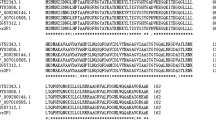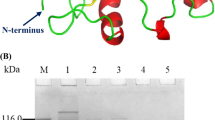Abstract
Pathogens have evolved an array of strategies to establish a productive infection. The extracellular proteins secreted by pathogens are one of unique mechanisms to evade the host innate immune response. Many secretory proteins transported by the bacterial secretion systems have been widely investigated in Salmonella. Certain extracellular nucleases are essential for bacterial pathogenesis. However, there is no current data available for the enzymatic properties of the proteins secreted by Salmonella. Therefore, in the present study we have identified and characterized the nuclease activity of the extracellular proteins from Salmonella enterica serovar Typhimurium. It was demonstrated that the extracellular proteins from S. Typhimurium exhibited the deoxyribonucleases activity against λDNA by agarose gel electrophoresis and agar plate diffusion method. The activity was observed at 16 °C, 37 °C and 42 °C, and found to be highest at 42 °C and inhibited at temperatures over 60 °C. The nuclease activity was stable under alkaline conditions (pH 7–10) and the optimum pH was 9.0. The nuclease activity was promoted at high ionic strength of Ba2+, Ca2+, Mg2+, and Ni2+. Nuclease zymography analysis revealed that there were four activity bands in the extracellular proteins; followed by LC-ESI/MS/MS analysis seven proteins were identified. As demonstrated by nuclease zymography, the recombinant 5′-nucleotidase protein expressed in the prokaryotic expression system displayed the DNase activity. To our knowledge, the present findings represent the first direct and unambiguous demonstration of the nuclease activity of the extracellular proteins from S. Typhimurium, and it provides an important fundamental for further investigation of the role of the extracellular proteins in pathogenicity and immune evasion.






Similar content being viewed by others
Abbreviations
- T3SSs:
-
Type III secretion systems
- SPIs:
-
Salmonella Pathogenicity islands
- SCV:
-
Salmonella-Containing vacuole
- NETs:
-
Neutrophil extracellular traps
- SDS:
-
Sodium dodecyl sulfate
- BCA:
-
Bicinchoninic acid
- IPTG:
-
Isopropyl ß-d-1-thiogalactoside
- TEMED:
-
N,N,N′,N′-Tetramethylethylenediamine
References
Malik-Kale P, Jolly CE, Lathrop S, Winfree S, Luterbach C, Steele-Mortimer O (2011) Salmonella—at home in the host cell. Front Microbiol 2:125
Fuche FJ, Sow O, Simon R, Tennant SM (2016) Salmonella serogroup C: current status of vaccines and why they are needed. Clin Vaccine Immunol 23(9):737–745
Wang W, Baloch Z, Zou M, Dong Y, Peng Z, Hu Y, Xu J, Yasmeen N, Li F, Fanning S (2018) Complete genomic analysis of a Salmonella enterica Serovar Typhimurium isolate cultured from ready-to-eat pork in China carrying one large plasmid containing mcr-1. Front Microbiol 9:616
Kurtz JR, Goggins JA, McLachlan JB (2017) Salmonella infection: interplay between the bacteria and host immune system. Immunol Lett 190:42–50
Silva LM, Munoz-Caro T, Burgos RA, Hidalgo MA, Taubert A, Hermosilla C (2016) Far beyond phagocytosis: phagocyte-derived extracellular traps act efficiently against protozoan parasites in vitro and in vivo. Mediators Inflamm 2016:5898074
Le KY, Park MD, Otto M (2018) Immune evasion mechanisms of Staphylococcus epidermidis biofilm infection. Front Microbiol 9:359
Anne J, Economou A, Bernaerts K (2017) Protein secretion in gram-positive bacteria: from multiple pathways to biotechnology. Curr Top Microbiol Immunol 404:267–308
Hume PJ, Singh V, Davidson AC, Koronakis V (2017) Swiss army pathogen: the Salmonella entry toolkit. Front Cell Infect Microbiol 7:348
Pezoa D, Yang HJ, Blondel CJ, Santiviago CA, Andrews-Polymenis HL, Contreras I (2013) The type VI secretion system encoded in SPI-6 plays a role in gastrointestinal colonization and systemic spread of Salmonella enterica serovar Typhimurium in the chicken. PLoS ONE 8(5):e63917
Freudl R (1992) Protein secretion in gram-positive bacteria. J Biotechnol 23(3):231–240
Teng TS, Ji AL, Ji XY, Li YZ (2017) Neutrophils and immunity: from bactericidal action to being conquered. J Immunol Res 2017:9671604
Liu J, Sun L, Liu W, Guo L, Liu Z, Wei X, Ling J (2017) A nuclease from Streptococcus mutans facilitates biofilm dispersal and escape from killing by neutrophil extracellular traps. Front Cell Infect Microbiol 7:97
Doke M, Fukamachi H, Morisaki H, Arimoto T, Kataoka H, Kuwata H (2017) Nucleases from Prevotella intermedia can degrade neutrophil extracellular traps. Mol Oral Microbiol 32(4):288–300
Sittenfeld A, Raventos H, Cruz R, Gutierrez JM (1991) DNase activity in Costa Rican crotaline snake venoms: quantification of activity and identification of electrophoretic variants. Toxicon 29(10):1213–1224
Detwiler C, MacIntyre R (1978) A genetic and developmental analysis of an acid deoxyribonuclease in Drosophila melanogaster. Biochem Genet 16(11–12):1113–1134
Young AM, Palmer AE (2017) Methods to illuminate the role of Salmonella effector proteins during infection: a review. Front Cell Infect Microbiol 7:363
Bergeron JRC, Brockerman JA, Vuckovic M, Deng W, Okon M, Finlay BB, McIntosh LP, Strynadka NCJ (2018) Characterization of the two conformations adopted by the T3SS inner-membrane protein PrgK. Protein Sci 27(9):1680–1691
Matelska D, Steczkiewicz K, Ginalski K (2017) Comprehensive classification of the PIN domain-like superfamily. Nucleic Acids Res 45(12):6995–7020
Desai NA, Shankar V (2003) Single-strand-specific nucleases. FEMS Microbiol Rev 26(5):457–491
Iiyama K, Lee JM, Tatsuke T, Mon H, Kusakabe T (2016) Expression and characterization of recombinant Serratia liquefaciens nucleases produced with baculovirus-mediated silkworm expression system. Mol Biotechnol 58(6):393–403
Mizuta R, Mizuta M, Araki S, Shiokawa D, Tanuma S, Kitamura D (2006) Action of apoptotic endonuclease DNase gamma on naked DNA and chromatin substrates. Biochem Biophys Res Commun 345(2):560–567
Davies AM, Hershman S, Stabley GJ, Hoek JB, Peterson J, Cahill A. (2003) A Ca2+-induced mitochondrial permeability transition causes complete release of rat liver endonuclease G activity from its exclusive location within the mitochondrial intermembrane space. Identification of a novel endo-exonuclease activity residing within the mitochondrial matrix. Nucleic Acids Res 31(4):1364–1373
Vandooren J, Geurts N, Martens E, Van den Steen PE, Opdenakker G (2013) Zymography methods for visualizing hydrolytic enzymes. Nat Methods 10(3):211–220
Napirei M, Ricken A, Eulitz D, Knoop H, Mannherz HG (2004) Expression pattern of the deoxyribonuclease 1 gene: lessons from the Dnase1 knockout mouse. Biochem J 380(Pt 3):929–937
Liao C, Liu M, Bai X, Liu P, Wang X, Li T, Tang B, Gao H, Sun Q, Liu X, Zhao Y, Wang F, Wu X, Boireau P, Liu X (2014) Characterisation of a plancitoxin-1-like DNase II gene in Trichinella spiralis. PLoS Negl Trop Dis 8(8):e3097
Fischer H, Scherz J, Szabo S, Mildner M, Benarafa C, Torriglia A, Tschachler E, Eckhart L (2011) DNase 2 is the main DNA-degrading enzyme of the stratum corneum. PLoS ONE 6(3):e17581
Zimmermann H (1992) 5'-Nucleotidase: molecular structure and functional aspects. Biochem J 285(Pt 2):345–365
Zakataeva NP, Romanenkov DV, Yusupova YR, Skripnikova VS, Asahara T, Gronskiy SV (2016) Identification, heterologous expression, and functional characterization of Bacillus subtilis YutF, a HAD superfamily 5'-nucleotidase with broad substrate specificity. PLoS ONE 11(12):e0167580
Soh KY, Loh JMS, Proft T (2018) Orthologues of Streptococcus pyogenes nuclease A (SpnA) and Streptococcal 5'-nucleotidase A (S5nA) found in Streptococcus iniae. J Biochem 164(2):165–171
Maiuolo J, Oppedisano F, Gratteri S, Muscoli C, Mollace V (2016) Regulation of uric acid metabolism and excretion. Int J Cardiol 213:8–14
Itoh R (2013) Enzymatic properties and physiological roles of cytosolic 5'-nucleotidase II. Curr Med Chem 20(34):4260–4284
Zheng L, Khemlani A, Lorenz N, Loh JM, Langley RJ, Proft T (2015) Streptococcal 5'-nucleotidase A (S5nA), a novel Streptococcus pyogenes virulence factor that facilitates immune evasion. J Biol Chem 290(52):31126–31137
Ma F, Guo X, Fan H (2017) Extracellular nucleases of Streptococcus equi subsp. zooepidemicus degrade neutrophil extracellular traps and impair macrophage activity of the host. Appl Environ Microbiol 83(2):e02468-16
Acknowledgments
This was supported by the National Natural Science Foundation of China (31572489, 31702219 and 31802159), PhD Start-up Fund of Henan University of Science and Technology (13480071), Henan Science and Technology Key Project (182102110061).
Author information
Authors and Affiliations
Corresponding authors
Ethics declarations
Conflict of interest
The authors declare no conflict of interest.
Additional information
Publisher's Note
Springer Nature remains neutral with regard to jurisdictional claims in published maps and institutional affiliations.
Rights and permissions
About this article
Cite this article
Liao, C., Zhang, M., Cheng, X. et al. Identification and Characterization of the Nuclease Activity of the Extracellular Proteins from Salmonella enterica Serovar Typhimurium. Curr Microbiol 77, 3651–3660 (2020). https://doi.org/10.1007/s00284-020-02201-1
Received:
Accepted:
Published:
Issue Date:
DOI: https://doi.org/10.1007/s00284-020-02201-1




